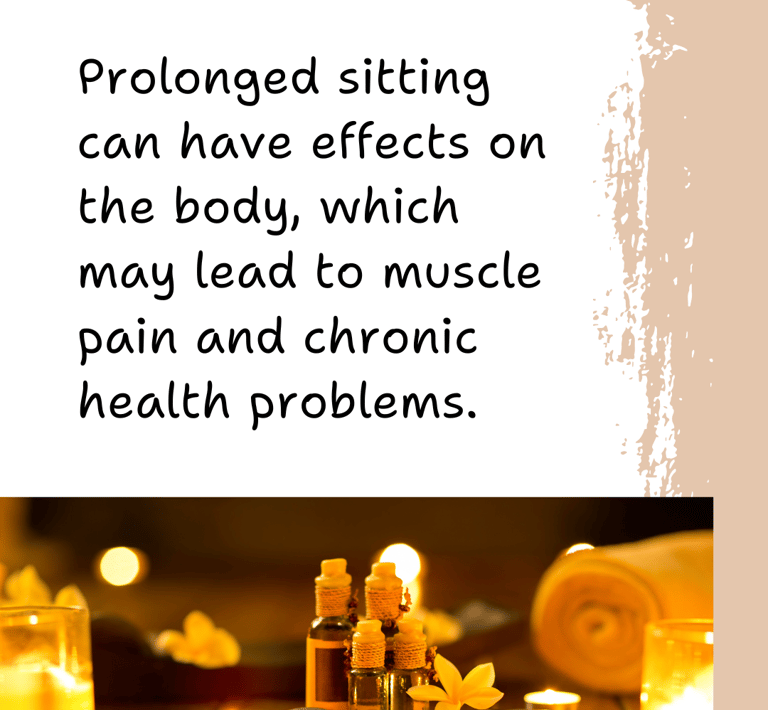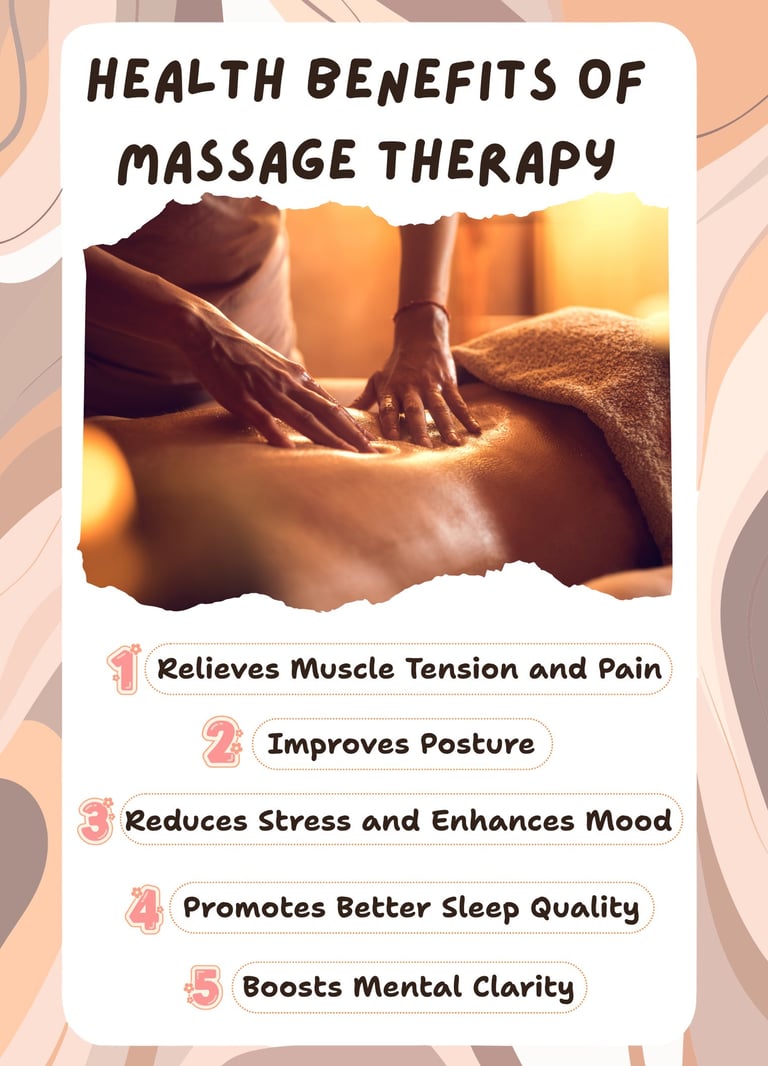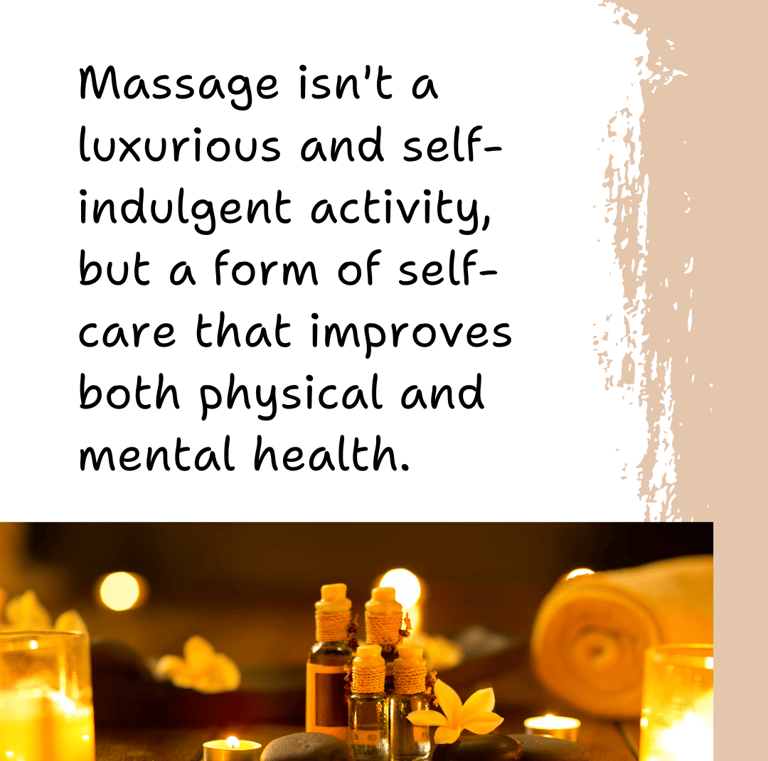"Unknot" Your Body and Mind: The Benefits of Massage for Desk Workers
As a nurse turned writer, I’ve experienced how long hours at a desk can take a toll on both the body and mind. In this blog post, I explore the benefits of massage therapy, how it transformed my well-being, and why it should be a part of every desk worker's self-care routine.
HEALTH & WELLNESS MADE SIMPLE
Sheri Anne Maximille Cabañes-Madayag
8/17/20257 min read


Disclaimer: This blog post is based on personal and professional experience and is intended for informational and educational purposes only. This is not a substitute for professional medical advice, diagnosis, or treatment. Always consult with your healthcare provider for specific questions or concerns regarding your health.
I used to think working at a desk was easier than being a nurse caring for patients at the bedside. When I traded the stethoscope for a keyboard, I realized that sitting on a desk for long hours was no joke.
After years of spending 8+ hours of desk work daily.
❌ Hunched over a desk.
❌ Eyes glued to the computer screen.
❌ Spine rounding.
❌ Shoulders moving up to my ears.
I realized that desk work can take a toll on our health.
But we don't have to worry. There is a secret weapon to counter the strain from hours of desk work.
It's called massage therapy.
In this blog post, we'll take a closer look at why massage therapy is no longer a luxury. It is an essential routine for every desk worker in today's era.
What This Blog Post Covers:
Keep reading to know how massage can help restore balance to both body and mind.
The Desk as a Hotspot for Health Issues
You've probably heard that "Sitting is the new smoking." Prolonged sitting can have effects on the body, which may lead to muscle pain and chronic health problems.
Some of the health effects of prolonged sitting include:
Stiff neck and shoulders
Hunching over a desk causes the shoulders to round forward, creating tension in the upper trapezius muscles. The trapezius muscles are located on either side of the upper back and help move the head, neck, and upper back. During prolonged sitting, the neck muscles become tight from holding the head up against gravity, leading to neck stiffness and pain.
Tight hips and back
The hip flexors are the muscles at the front of the hip that help lift the leg closer to the chest. Prolonged sitting causes the hip flexors to tighten and shorten, which pulls the lower back and causes back pain. Poor posture while sitting can also compress the discs in the spine, which can lead to chronic back pain.
Weak glutes and legs
When sitting for extended periods, we don't use our glutes and leg muscles. This causes the muscles to weaken.
Weight gain
While this effect of prolonged sitting may not be resolved with massage therapy, it is still worth mentioning. A sedentary lifestyle or spending long hours sitting or lying down can cause weight gain. Sitting for long hours means the body burns fewer calories. Excess calories in the body cause weight gain
Increased risk for chronic diseases
In connection with weight gain, prolonged sitting increases the risk of developing lifestyle-related diseases, like diabetes, hypertension, and heart disease. A 2017 study found that sitting for more than 8 hours a day is associated with a 17% higher chance of developing diabetes. Prolonged sitting also results in significant increases in blood pressure, as concluded in a 2021 study. Similarly, according to a study in 2019, higher levels of total daily sitting time are associated with an increased risk of cardiovascular disease and diabetes.
To sum up, prolonged sitting can have harmful effects on our health. The most common being chronic muscle pain. Too much sitting also increases the risk of lifestyle-related diseases.


How Massage Transforms The Body and Mind
Back when I was a nurse working in the hospital, I frequently experienced pain in my lower back and legs. These are from lifting and turning patients and walking during patient rounds. Now that I'm a writer and a virtual assistant, I still have back and neck pain. Sometimes, I treat myself to a full-body massage.
Massage therapy is the practice of manipulating the body's soft tissues and muscles to promote health and well-being. It is done by a massage therapist, who uses their hands, sometimes forearms, or elbows to apply pressure to the muscles and soft tissues.
Regular massage therapy works wonders in restoring our mind and body. Let's dive in to see the benefits of massage therapy:
1. Relieves Muscle Tension and Pain
Prolonged sitting and repetitive movement from desk work cause muscle knots to develop. These muscle knots are spots of tense muscles that are often painful. Massage targets the muscle knots in the neck, shoulders, and lower back. It improves blood flow to the muscles and releases muscle tension. As the knots are released, muscle pain is also relieved.
2. Improves Posture
Maintaining an unnatural position, like during desk work, can cause stiff and tight muscles. Massage helps improve posture by realigning and releasing tight muscles. These allow the body to restore its natural alignment, supporting proper posture.
3. Reduces Stress and Enhances Mood
Massage not only benefits physical health. It also promotes mental health through its calming and relaxing effects. Massage therapy reduces cortisol levels (stress hormone) and boosts serotonin and dopamine levels (feel-good hormones). These effects of massage help with stress relief and a better mood.
4. Promotes Better Sleep Quality
Long hours of desk work and stress can make it hard to sleep at night. Due to its relaxation and stress reduction benefits, massage promotes deeper sleep. This makes us feel more well-rested and refreshed after a good night's sleep. A recent 2025 study revealed that massage therapy before bedtime can also improve the sleep quality of individuals with symptoms of insomnia.
5. Boosts Mental Clarity
Massage helps improve mental clarity by reducing stress and promoting better sleep quality. Studies also suggest that massage enhances cognitive function, which involves mental processes like memory, attention, critical thinking, and problem-solving. When our body is relaxed, pain-free, and well-rested, our mind no longer thinks about the pain, stress, and fatigue. This clears the mind, creating more space for creative thinking. Our focus and concentration improve, making us more productive at work.


The Difference Massage Made In My Health and Well-being
I used to view massage as a treat reserved only for special occasions, like my birthday or when celebrating huge milestones. I didn't always prioritize self-care until I got stressed, exhausted, and felt a lot of pain in my neck and upper back. So, I went to visit a spa near me for a massage.
I've always had muscle knots between my shoulder blades and stiffness in my neck. The massage therapist advised me to get a regular massage, even just monthly. I followed her advice and felt the awesome benefits of regular massage therapy.
With regular massage, I've felt relief from the pain caused by muscle knots and stiffness. I also noticed improvements in my mood. I am no longer always grumpy and stressed. I feel calmer and relaxed most of the time. I became more focused and productive at work and in my creative pursuits.
Prioritizing self-care, in the form of a monthly massage, improved my overall health and well-being. Now, I always look forward to my monthly massage sessions, so I can recharge and feel better.
Making Massage Work for Your Lifestyle
I understand that not everyone has the time or budget for a spa visit. I used to think the same. But after experiencing the benefits of massage, I realized that investing in our health should always be a priority.
You don't need to book a massage session in an expensive spa. Many massage therapists or spas offer affordable packages or special discounts for regular customers. You can search online for spas or massage therapists near your area, and compare their services and rates. A massage session in the spa I frequently visit costs about $8-10. Consider getting a massage every two weeks, monthly, or even every two months, depending on what works best with your schedule and budget.
In between massage sessions, I do these practical approaches to relieve muscle tension and pain, which you can also try:
Take 5-minute breaks every hour to stretch or move around.
Try self-massage using a foam roller or tennis balls.
Apply a warm compress over the painful areas on the neck and shoulders.
Remember that it is always best to consult your doctor or a professional massage therapist before trying to relieve muscle tension and pain on your own.
Your Mind and Body are Worth the Investment
Massage isn't a luxurious and self-indulgent activity. It is a form of self-care that improves both physical and mental health. The money you spend on regular massage sessions can help you save from costly medical treatments for the health problems caused by prolonged sitting at the desk.
When your body feels good and your mind is clear, everything improves: posture, focus, mood, and productivity. A healthy mind and body help you work more efficiently to reach your goals. It gives you the energy and mindset to face challenges and enjoy life's greatest moments.
So take a moment to reflect. Maybe it's time to schedule that massage you've been putting off for a long time. Your future, muscle-pain-free, and relaxed self will thank you for it.
Are you considering including regular massage therapy in your lifestyle?
Or have you tried and experienced the benefits of massage therapy?
I'd love to hear your thoughts. Feel free to reach out through my contact page.


Note: This post is for informational purposes only and is not a substitute for professional medical advice. Please speak with your healthcare provider about your specific health concerns.
